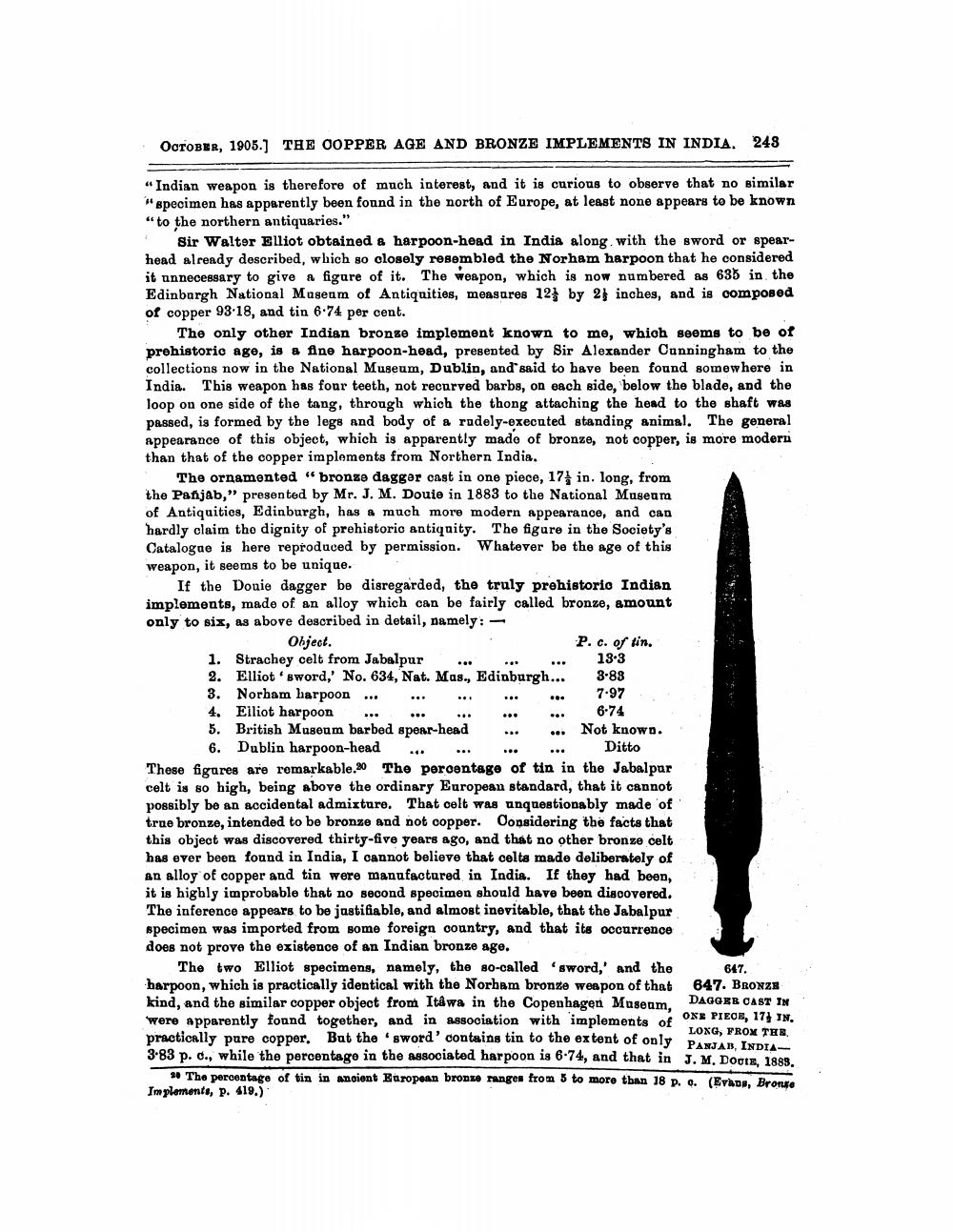________________
OCTOBER, 1905.] THE COPPER AGE AND BRONZE IMPLEMENTS IN INDIA. 248
"Indian weapon is therefore of much interest, and it is curious to observe that no similar "specimen has apparently been found in the north of Europe, at least none appears to be known "to the northern antiquaries."
Sir Walter Elliot obtained a harpoon-head in India along with the sword or spearhead already described, which so closely resembled the Norham harpoon that he considered it unnecessary to give a figure of it. The weapon, which is now numbered as 635 in the Edinburgh National Museum of Antiquities, measures 12 by 2 inches, and is composed of copper 93.18, and tin 6.74 per cent.
The only other Indian bronze implement known to me, which seems to be of prehistoric age, is a fine harpoon-head, presented by Sir Alexander Cunningham to the collections now in the National Museum, Dublin, and said to have been found somewhere in India. This weapon has four teeth, not recurved barbs, on each side, below the blade, and the loop on one side of the tang, through which the thong attaching the head to the shaft was passed, is formed by the legs and body of a rudely-executed standing animal. The general appearance of this object, which is apparently made of bronze, not copper, is more modern than that of the copper implements from Northern India.
The ornamented "bronze dagger cast in one piece, 17 in. long, from the Panjab," presented by Mr. J. M. Douie in 1883 to the National Museum of Antiquities, Edinburgh, has a much more modern appearance, and can hardly claim the dignity of prehistoric antiquity. The figure in the Society's Catalogue is here reproduced by permission. Whatever be the age of this weapon, it seems to be unique.
If the Douie dagger be disregarded, the truly prehistoric Indian implements, made of an alloy which can be fairly called bronze, amount only to six, as above described in detail, namely: -
Object.
1. Strachey celt from Jabalpur
2.
Elliot sword,' No. 634, Nat. Mas., Edinburgh...
3. Norham harpoon
4. Elliot harpoon
5. British Museum barbed spear-head
6. Dublin harpoon-head
*4*
...
P. c. of tin.
13.3
3-88
7.97
6-74 Not known. Ditto
These figures are remarkable.20 The percentage of tin in the Jabalpur celt is so high, being above the ordinary European standard, that it cannot possibly be an accidental admixture. That celt was unquestionably made of true bronze, intended to be bronze and not copper. Considering the facts that this object was discovered thirty-five years ago, and that no other bronze celt has ever been found in India, I cannot believe that celts made deliberately of an alloy of copper and tin were manufactured in India. If they had been, it is highly improbable that no second specimen should have been discovered. The inference appears to be justifiable, and almost inevitable, that the Jabalpur specimen was imported from some foreign country, and that its occurrence does not prove the existence of an Indian bronze age.
The two Elliot specimens, namely, the so-called 'sword,' and the harpoon, which is practically identical with the Norham bronze weapon of that kind, and the similar copper object from Itâwa in the Copenhagen Museum, were apparently found together, and in association with implements of practically pure copper. But the 'sword' contains tin to the extent of only 3-83 p. c., while the percentage in the associated harpoon is 6-74, and that in
647.
647. BRONZE DAGGER CAST IN ONE PIECE, 17 IN. LONG, FROM THE
PANJAB, INDIA J. M. DOGIE, 1883.
20 The percentage of tin in ancient European bronze ranges from 5 to more than 18 p. e. (Evans, Bronse Implements, p. 419.)




